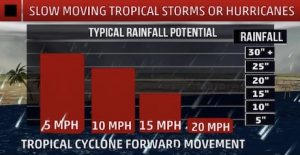
Transportation Statistics
July 3, 2019
The Flooding Next Time
July 17, 2019Preparing for Bad Weather

The Cost of a Slow Storm
Here we are, again, in hurricane season. Tropical Storm Barry is forming in the Gulf, battering southern Louisiana with torrential rain. Moving slowly, it’s likely to generate 2-8 inches of rain from the Florida Panhandle to the Texas coast.
Barry moving so slowly makes the potential for catastrophic rainfall and flooding all the more possible. Simply: the slower a storm moves, the more time it has to drop rain.
With its warm summer water temperature and circular wind patterns, the Gulf provides a seemingly never-ending potential for drenching rains and damaging winds, whether they develop into hurricane status or not. Contributing to the bad mix are the warmer than usual temperatures in the Gulf right now; we’re seeing temperatures that are typical for August, here in July.
The transportation industry is essential to these recovery and rebuilding efforts. Our trucks remove storm-damaged vehicles and debris. They bring in food and clothing and building supplies.
And yet, they only do so when it’s safe. There’s no sense in an 18-wheeled vehicle contributing to clogged roadways. That’s why highway patrols and FEMA coordinate to keep roads closed until safe passage is secured. That’s why third-party logistics companies coordinate with state and federal agencies and carriers and dispatch. We never send our carriers into harm’s way.

The Weather a-Swirl, Again
And, in a great use of technology, the industry is able to post, evaluate, and deliver to real-time needs of communities. Alongside trusted resources like Truckstop.com’s load board, initiatives like American Logistics Aid Network (ALAN) provide supply chain assistance to disaster relief organizations.
Meteorologists are predicting “2019 to result in a near- to slightly above-normal season with 12 to 14 storms.” That’s 12 to 14 storms too many. And while we don’t at all like the loss of life and livelihood and home and business, we’ve been here before. We dry out, we recover, we rebuild, and we move forward.

